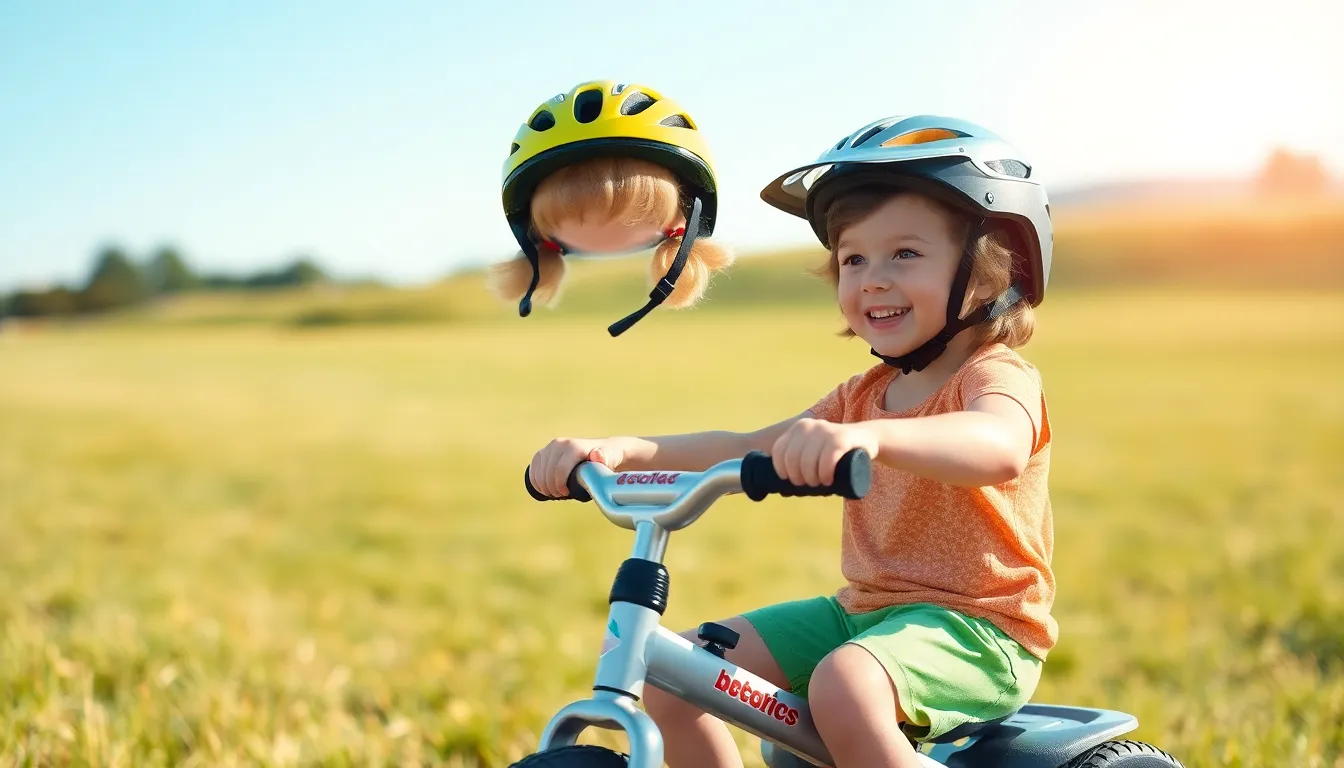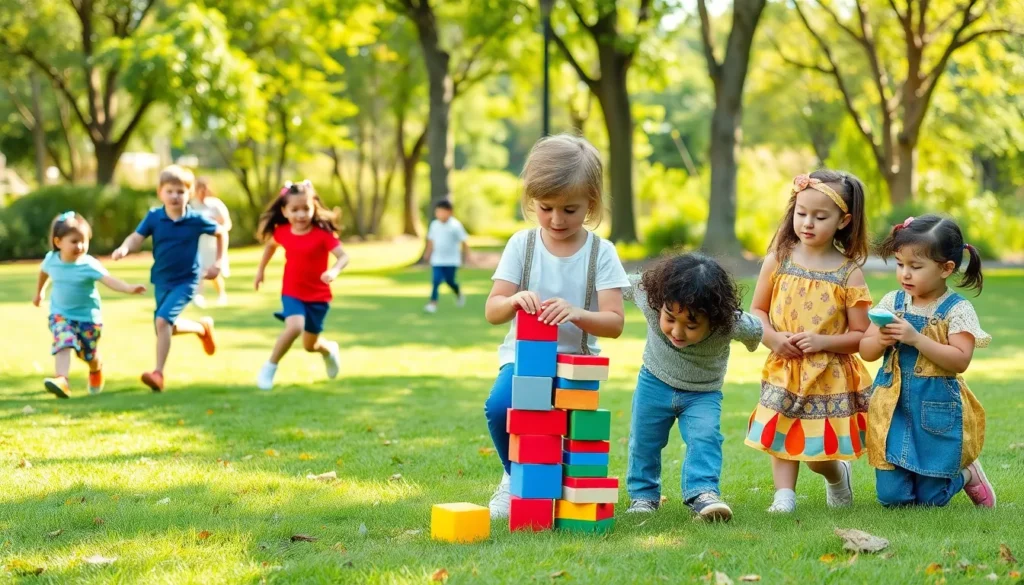Table of Contents
ToggleWhen it comes to raising kids, understanding the four domains of child development is like having a secret map to the treasure chest of parenting. These domains—physical, cognitive, social-emotional, and language—work together like a well-oiled machine, helping children grow into the amazing humans they’re meant to be.
Imagine trying to bake a cake without knowing the ingredients; that’s what parenting feels like without grasping these developmental areas. Each domain plays a crucial role, and neglecting one can lead to a recipe for disaster. So buckle up as we dive into this essential guide that’ll not only enlighten you but might just make you chuckle along the way. After all, who said learning about child development couldn’t be fun?
Overview of the 4 Domains of Child Development
Child development encompasses four distinct yet interconnected domains: physical, cognitive, social-emotional, and language. Each domain plays a vital role in a child’s overall growth and well-being.
Physical development involves the enhancement of gross and fine motor skills. Children gain strength, coordination, and control over their movements. A child who can play catch at age five shows progress in this area.
Cognitive development focuses on mental processes such as thinking, problem-solving, and memory. This domain influences a child’s ability to learn new concepts and understand their environment. For instance, when a three-year-old begins to sort shapes, cognitive skills are advancing.
Social-emotional development addresses the ability to interact with others and manage emotions. Children learn to recognize feelings in themselves and peers, which is essential for forming friendships. A child demonstrating empathy towards a classmate who feels sad illustrates growth in this domain.
Language development includes communication skills, from babbling in infancy to forming sentences by age two. This domain affects not only vocabulary acquisition but also comprehension abilities. A five-year-old articulating thoughts clearly indicates successful language development.
Each domain intertwines, influencing a child’s overall development. A child thriving in one area often sees benefits in others. Understanding these domains equips parents with the knowledge to support and guide their children’s growth effectively.
Physical Development

Physical development is vital in a child’s early years. It includes significant advancements in gross and fine motor skills.
Gross Motor Skills
Gross motor skills encompass movements that involve large muscle groups. Children develop abilities like running, jumping, and climbing as they grow. Coordination improves with activities such as playing catch or riding a tricycle. A two-year-old may start walking, while a five-year-old demonstrates increased balance and agility. Engaging in outdoor play enhances these skills, providing opportunities for exploration and physical activity. Parents can encourage this growth by offering spacious areas for movement and safe play equipment. Regular, active engagement remains essential for fostering strength and coordination.
Fine Motor Skills
Fine motor skills involve the coordination of small muscles, particularly in the hands and fingers. Skills like grasping, pinching, and manipulating objects become prominent as children age. By age three, many can stack blocks or use scissors effectively. A five-year-old may begin writing or drawing, showcasing their control over hand movements. Encouraging activities like coloring or assembling puzzles aids in honing these skills. Providing sufficient opportunities for practice allows children to develop dexterity and hand-eye coordination. Supporting fine motor skill development plays a crucial role in preparation for later academic tasks.
Cognitive Development
Cognitive development encompasses the mental processes that enable thinking, learning, and problem-solving. This domain plays a crucial role in how children make sense of the world.
Problem Solving
Problem solving involves the ability to identify, analyze, and find solutions. A child might display this skill when figuring out how to stack blocks without them toppling over. Engaging in activities that challenge a child’s thinking fosters logical reasoning and critical thinking skills. Puzzles and age-appropriate games serve as excellent tools to enhance this capability. Observing a child successfully solve a problem boosts their confidence and creates a foundation for future learning.
Language Acquisition
Language acquisition refers to the natural progression of learning to communicate. Children typically begin this process from infancy, starting with cooing and babbling before progressing to words and sentences. By age five, many can express complete thoughts clearly. This growth in language skills correlates with cognitive development and social interaction. Engaging in conversations and reading regularly to children significantly supports their language development. Exposure to diverse vocabulary and sentence structures enriches a child’s linguistic abilities.
Social and Emotional Development
Social and emotional development involves a child’s ability to form relationships and understand their emotions. This domain significantly influences how children interact with others and manage feelings.
Building Relationships
Children develop strong relationships through regular social interactions. Forming friendships at an early age lays the foundation for effective communication skills. They learn sharing and cooperation while playing with peers, which enhances social skills. Participating in group activities fosters teamwork, teaching children to work collaboratively toward common goals. Recognizing and responding to social cues is essential during this stage. By observing others, children understand the dynamics of friendships and learn conflict resolution. The quality of these early relationships shapes their future interactions.
Understanding Emotions
Recognizing and managing emotions play a pivotal role in social-emotional development. Children first identify basic emotions, like happiness and sadness, through experiences. They gain awareness of their feelings and learn to express them appropriately. Engaging in discussions about emotions enhances their emotional vocabulary. Using stories and role-playing allows them to explore different emotional scenarios. Parents can guide children by modeling emotional responses, demonstrating empathy, and encouraging them to share their feelings. This understanding helps children navigate complex social situations effectively. Developing emotional intelligence significantly contributes to a child’s overall well-being.
Creative Development
Creative development centers on fostering children’s ability to express themselves through various forms of imaginative play and artistic expression. Such activities enhance cognitive skills and emotional understanding.
Imaginative Play
Imaginative play allows children to explore different scenarios and roles, enriching their understanding of the world. This type of play often includes pretending to be different characters during games, which boosts creativity and problem-solving skills. Role-playing with peers nurtures social interactions, helping kids learn cooperation and negotiation. Engaging in imaginative play encourages children to experiment with different situations, enhancing their emotional intelligence. Parents may facilitate this kind of play by providing props, costumes, or storylines, allowing children to dive into different adventures.
Artistic Expression
Artistic expression involves various forms of creativity, such as drawing, painting, and crafting. These activities provide outlets for self-expression and enable children to communicate their feelings. Children develop fine motor skills while manipulating art materials, which also supports hand-eye coordination. Creating art allows them to explore colors, shapes, and textures while promoting critical thinking. It’s beneficial for parents to encourage artistic activities by setting up creative spaces filled with materials, making art accessible and enjoyable. Regular exposure to artistic expression aids cognitive growth and enhances emotional well-being, serving as a vital component of overall child development.
Recognizing the four domains of child development is vital for nurturing well-rounded children. Each domain plays a unique role in shaping a child’s growth and influences their ability to thrive in various aspects of life. By understanding physical, cognitive, social-emotional, and language development, parents can create supportive environments that foster exploration and learning.
Emphasizing the interconnectedness of these domains allows for a holistic approach to parenting. This knowledge empowers parents to actively engage in their children’s lives, ensuring they develop essential skills and emotional resilience. With this foundation, children are better equipped to navigate the complexities of the world around them.







